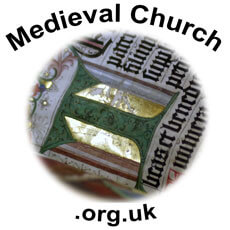Photius (c.810-c.895)
Theology on the Web helps over 2.5 million people every year to find high quality theological resources that will help to equip them to serve God and to know Him better (2 Timothy 2:15). Like other websites that provide free services, it is dependent on donations to enable it to grow and develop and only 0.004% of visitors currently do so. If you would like to support this site, please use one of the options to the right of this message.
Synopsis
PHOTIUS, b. in the first decade of the ninth century; d. in 891. In 846 the Empress Theodora, regent during the minority of her son Michael III., appointed Ignatius, the youngest son of Michael I., and a man of unblemished character, Patriarch of Constantinople. Bardas, however, the vicious uncle of Michael III., succeeded in estranging the young emperor from his mother; and when Ignatius refused to force Theodora into a nunnery, and in 857 even dared to exclude Bardas from the Lord’s Supper on account of his abominable behavior, the latter had him deposed, and banished to the Island of Terebintha. The patriarchal see of Constantinople thus became vacant, and Bardas was looking about for a fit occupant. His choice fell upon Photius.
Photius was rich; he belonged to a distinguished family; he held a prominent position in public life; and he was already celebrated as one of the most learned men of his time: but he was not a theologian. Of course, as he had studied the science of time age in its widest compass, he was well acquainted with the Christian dogmas, and well versed in ecclesiastical affairs. But his official position was that of prolospatharios, or captain of the body-guard; and he had been most active as a diplomate. It was not without precedence, however, that a layman was raised to time patriarchal see; though it certainly looked a little strange that Gregory of Syracuse, a bitter enemy of Ignatius, in five days hurried him through the five orders of monk, lector, subdeacon, deacon, and presbyter, and on the sixth consecrated him patriarch. But Ignatius could not be made to submit, though a synod of Constantinople (859) confirmed his deposition and condemnation. He found support in the West, amid soon the whole clergy of the Eastern Church was divided into two hostile parties. The emperor addressed a letter to the Pope, asking him to interfere; and Photius also wrote to him, modestly, even submissively, and defending himself with great shrewdness and tact. Nicholas I. accepted the invitation; but, on the basis of the newly introduced pseudo-Isidorian decretals, he accepted it, not as mediator, but as judge. He sent two bishops - Rhadoald of Porto, amid Zacharias of Anagni - as legates to Constantinople, where a numerously attended synod was convened in 861. By intrigues, and, as some say, by violence, Ignatius was forced to resign, and Photius was recognized. The latter again wrote to the Pope in order to explain the position, and, if possible, to gain his favor. But Nicholas I. had now become fully informed about the true state of the affairs. In 863 he convened a synod in Rome, punished the legates for disobedience, and excommunicated Photius. The emperor answered in a letter full of furious invectives. The new papal embassy was not allowed to enter Constantinople; and Photius at once changed attitude, turning the controversy between the patriarch of Constantinople and the bishop of Rome into a controversy between the Eastern and the Western Church. In 866 he issued his famous encyclical letter, in which he declared the whole Latin Church heretical on account of its clerical celibacy, its introduction of the word filioque into the creed, and its arrangement of the Quadragesimal Fast, and called upon all bishops, archbishops, and patriarchs of the Greek Church to unite firmly and cordially against the common foe.
The turn thus given to the course of affairs was of the greatest importance, and for a moment Photius seemed to have secured success. At a synod which was convened in Constantinople (867), and which, though it was packed, pretended to be oecumenical, he formally excommunicated the Pope. But in September, same year, Michael III. was assassinated; and the first act of his assassin and successor, Basilius Macedo, was to depose Photius, and recall Ignatius. Political calculations seem to have been the ruling motive for these proceedings. Basilius needed the support of the party of Ignatius and of the Pope; and consequently the papal supremacy was recognized, and the papal legates were again received in Constantinople. A synod was convened in 869; and Photius was not only deposed, but condemned as a liar, adulterer, parricide, and heretic, and shut up in the dungeon of a distant monastery, where he was even deprived of his books. As time rolled on, however, circumstances changed. Photius was allowed to return to Constantinople: he was even made tutor to the imperial princes. He was also reconciled to Ignatius; and, when the latter died (in 878), he quietly took possession of the patriarchal see. The Roman legates who were present at the synod of Constantinople (879) - the so-called Pseudosynodus Photiana - made no objection; and the frauds which had taken place at the two preceding synods were put down as the true cause of all the confusion. Even the Pope seemed willing to drop the case. He afterwards changed his mind, however; and in 882 he renewed the ban on Photius, which none of his successors could be induced to take away. Shortly after, Photius fell under the suspicion of political intrigues, and embezzlement of public money; and in 886 the emperor, Leo Philosophus, a son of Basilius, banished him to an Armenian monastery, where he remained for the rest of his life.
Whatever verdict may be given on Photius as
a church officer, his literary merits, not only in the field of theology, but
also in those of philology, canon law, and history of literature, are beyond
cavil. The principal monument which he has left of his erudition is his ![]() or
or ![]() a work unique in its kind, the product of a stupendous industry,
and the most comprehensive learning, an invaluable source of information.
According to the dedication to Tarasius, it was completed before he was
appointed patriarch. It consists of codices, that is, chapters of unequal
length, strung together without any material or chronological principle of
arrangement, and containing excerpts of books accompanied with historical and
critical notes on the work and the author. The circumstance, that, of authors
quoted, eighty are known to us only through this work, gives an idea of its
value; and his correctness in all points where lie can be controlled gives
guaranty for his correctness in general. The first edition of the work is that
by David Höschel, Augsburg, 1601: the latest and best known is that by Im.
Bekker, Berlin, 1824-25, 2 vols. Of great importance is also his
a work unique in its kind, the product of a stupendous industry,
and the most comprehensive learning, an invaluable source of information.
According to the dedication to Tarasius, it was completed before he was
appointed patriarch. It consists of codices, that is, chapters of unequal
length, strung together without any material or chronological principle of
arrangement, and containing excerpts of books accompanied with historical and
critical notes on the work and the author. The circumstance, that, of authors
quoted, eighty are known to us only through this work, gives an idea of its
value; and his correctness in all points where lie can be controlled gives
guaranty for his correctness in general. The first edition of the work is that
by David Höschel, Augsburg, 1601: the latest and best known is that by Im.
Bekker, Berlin, 1824-25, 2 vols. Of great importance is also his ![]() a collection of the canons of the Eastern Church, containing not
only the decrees of the councils, but also the ecclesiastical edicts of the
secular government. It is found, together with Balsamon’s conimentaries,
in Voellus and Justellus (Bibl. juris canon., ii., Paris, 1661). His Contra Manichæos, edited by Wolf, in his Anecd.
Græc., Hamburg, 1722, and also found in Gallandi (Bibl.,
XIII.), has a curious resemblance to the Historia Paulicianorum by
Petrus Siculus; but as Photius wrote his book before 867, and Petrus his after
868, it is the latter who bas borrowed from the former. The Liber de
spiritus sancti mystagogia, edited by Hergenröther, Ratisbon, 1857,
shows the dialectical art of the author, presenting numerous reasons why the
addition of filioque in the Latin creed is untenable. His letters, of
which there is a nearly complete edition by Moritagu, London, 1651, give many
interesting traits of his personal life and character. Several minor treatises
by him, besides his so-called Lexicon, London, 1822, 2 vole., have also
been published; a collected edition of his works is found in Migne’s Biblioth. Patr. Græca. CI-CIV.
a collection of the canons of the Eastern Church, containing not
only the decrees of the councils, but also the ecclesiastical edicts of the
secular government. It is found, together with Balsamon’s conimentaries,
in Voellus and Justellus (Bibl. juris canon., ii., Paris, 1661). His Contra Manichæos, edited by Wolf, in his Anecd.
Græc., Hamburg, 1722, and also found in Gallandi (Bibl.,
XIII.), has a curious resemblance to the Historia Paulicianorum by
Petrus Siculus; but as Photius wrote his book before 867, and Petrus his after
868, it is the latter who bas borrowed from the former. The Liber de
spiritus sancti mystagogia, edited by Hergenröther, Ratisbon, 1857,
shows the dialectical art of the author, presenting numerous reasons why the
addition of filioque in the Latin creed is untenable. His letters, of
which there is a nearly complete edition by Moritagu, London, 1651, give many
interesting traits of his personal life and character. Several minor treatises
by him, besides his so-called Lexicon, London, 1822, 2 vole., have also
been published; a collected edition of his works is found in Migne’s Biblioth. Patr. Græca. CI-CIV.
Gass, "Photius," Philip Schaff, ed., A Religious Encyclopaedia or Dictionary of Biblical, Historical, Doctrinal, and Practical Theology, 3rd edn, Vol. 4. Toronto, New York & London: Funk & Wagnalls Company, 1894. pp.1837-1838.
Primary Sources
| Photius, The Bibliotheca, N. Wilson, ed. Gerald Duckworth & Co. Ltd., 1994. Hbk. ISBN: 0715626124. pp.272. | |
| Photius, Homilies, Cyril Alexander Mango, translator. Dumbarton Oaks Studies 3. Cambridge, MA: Harvard University Press, 1958. pp. xii + 327. |
Secondary Sources
Related Subjects
 |
|
 |
|
 |





 D.S. White, Patriarch
Photios of Constantinople. His Life, Scholarly Contributions and Correspondence
Together With a Translation of Fifty-Two of His Letters: The Archbishop Iakovos Library of Ecclesiastical and
Historical Sources, No. 5. Brookline, MA: Holy Cross Orthodox Press, 1981. Hbk.
ISBN: 091658626X. pp.235.
D.S. White, Patriarch
Photios of Constantinople. His Life, Scholarly Contributions and Correspondence
Together With a Translation of Fifty-Two of His Letters: The Archbishop Iakovos Library of Ecclesiastical and
Historical Sources, No. 5. Brookline, MA: Holy Cross Orthodox Press, 1981. Hbk.
ISBN: 091658626X. pp.235.


